Content created: 2012-06-25
File last modified:
Go to first chapter (1)

The Tale of Huìnéng
The Platform Scripture of the Sixth Patriarch
(Liùzǔ Tán Jīng 六组坛经), Part 1
Introduction
Thus shall ye think of all this fleeting world:
A star at dawn, a bubble in a stream,
A flash of lightning in a summer cloud,
A flickering lamp, a phantom, and a dream.
Diamond Sutra (tr. A. F. Price, p. 145)
Chapter Links
Introduction
Chán 禅 Buddhism
Buddhism was transmitted from India to China, beginning almost immediately upon its institutionalization on its home soil in the centuries preceding the Common Era. Slightly different carriers (often deliberate missionaries) brought slightly different understandings of the faith, and transmitted slightly different scriptures, which were understood through slightly different translations by slightly different Chinese populations in slightly different circumstances. These "slight differences" had the potential eventually to become quite large, and not surprisingly, there was a good deal of variation in Chinese Buddhism.

One of the most important lines of Buddhist thought in China is Chán 禅, more often known in English as Zen, as pronounced in Japan. Chán is an East Asian variant of the Indian Dhyāna schools of Buddhism, which hold that Buddhist enlightenment happens “in a flash” rather than gradually. In English the term “subitist” is sometimes applied to this belief. The opposing term is “gradualist,” which refers to the belief that enlightenment occurs over a period of time through careful study and performing works of karmic merit.
It is in the nature of subitism that one grasps the whole system or none of it. All of us have had the experience of suddenly understanding something that was formerly obscure —I still remember the day when array variables abruptly made sense— or of understanding something with much less effort than seems to be necessary for other people. (Some people have an “intuitive” grasp of algebra, or music, or grammar, or military strategy, or etiquette, or auto mechanics, while others struggle with these subjects.) These experiences, while prosaic, are helpful in thinking about how Chán believers consider enlightenment. For Christian readers, St. Paul's vision on the road to Damascus can be a useful model of a "subitist" religious experience.
Chán Buddhism tends to devalue texts, study, and even meritorious works and to stress instead the sudden apprehension of the nature of reality. For Chán adherents, the signature religious exercise is meditation with the goal of experiencing such a flash of insight.
Nevertheless, Chán adherents do make use of texts, and The Platform Scripture of the Sixth Patriarch is widely read in Chán circles. The Sixth Patriarch was illiterate, and the text we have is traditionally ascribed to a monk named Fǎhǎi 法海. ("Dharma Sea"). It is considered to be a masterwork of Táng 唐 dynasty prose, with balanced and beautiful cadences and a well developed narrative structure.
Chán Patriarchs
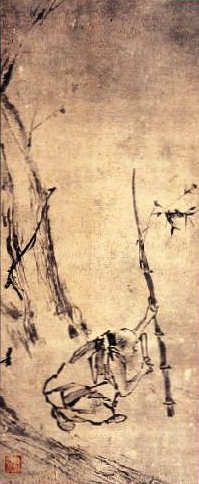
As a social movement within Buddhism, Chán is associated with an early line of 33 patriarchs (zǔ 祖, also translated as "ancestors"). Of these, the 28th was Bodhidharma (Pútídámó 菩提达摩), an Indian priest who brought the Dhyāna tradition to China. Bodhidharma, although an Indian, is regarded as the first of six Chinese patriarchs. The sixth and last of these (and hence the 33rd of the whole line) was Huìnéng 慧能 (638-713), the protagonist of the Platform Scripture chapter presented here.
The picture above, by an unidentified artist, rather pretentiously shows Huìnéng in the middle with the venerable Bodhidharma seated like a disciple at his right hand (our left side) and another patriarch (the Fifth?) seated at his left hand. He is more prosaically portrayed engaged in cutting bamboo in a work at the right by the Northern Sòng 宋 dynasty artist Liáng Kǎi 梁楷 (about 1140-1210). (There is a case to be made both ways for which representation he would have preferred.)
This Chapter
Once he is suddenly enlightened, the Sixth Patriarch, although illiterate, and not even a monk at the time, displays profound insight into scriptures that he cannot even read, and into doctrines he has never been taught. As one scholar writes,
Like the wind that blows where it wills, genius oft appears where it is least expected. Huìnéng … is one of such cases. He is assuredly one of the superlative geniuses that China has ever produced. (Wu 1967:56)
The story of how this happened makes up the first portion, or pǐn 品, of the scripture —about a quarter of it and the only part provided here. The remainder is given over to his discourses on how enlightenment occurs and what it means, as represented also in other Chán scriptures. (Huìnéng was extreme compared with earlier Chán interpreters, which won him enemies, even though his position eventually came to be especially revered.)
Return to top.
For purposes of the kinds of classes I have taught, this short biography, engagingly told in the first person, is a useful demonstration of the process of sudden enlightenment so central to Dhyāna thinking, but it also has a number of interesting subtexts:
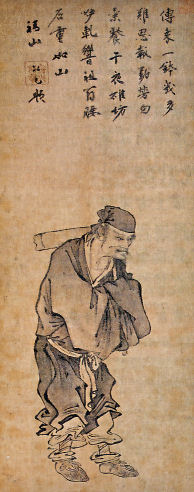
- For one, it is a classic rags-to-riches tale as a scullery lad suddenly is catapulted to the head of the Chán movement. This is a popular type of story in China, just as it is elsewhere in the world.
- For another, it is a window on surprisingly bitter intra-clergy rivalries which even the best positioned monks seem powerless to do much about.
- There is also a very explicit (and very Buddhist and very modern) theme of egalitarianism in this text: all people —even "barbarian" Cantonese— have the buddha-nature.
- But at the same time there is a kind of elitism: most people suffer in a fog of delusion and cannot save themselves without expert instruction, which comes from masters of immeasurable venerability. (This is true even though enlightenment, when it hits, is a very personal experience, which cannot be communicated or shared.)
There is more to the story, of course. In the seventh pǐn, for example, Huìnéng's nemesis, the head monk Shénxiù 神秀, moves north and becomes the head of a gradualist school of Buddhism.
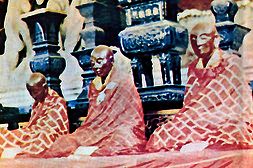
After his death, Huìnéng's mummy was covered with gold, and today, 1300 years later, it is still an object of veneration in Nánhuá Sì 南华寺 monastery in Cáoxī 曹溪. It is said to be the figure shown in the middle at right. (During the Cultural Revolution there were rumors that it had been destroyed by the Red Guards, which casts some doubt on whether the figure seen today is Huìnéng or not.)
Return to top.
This Translation
I made the present translation largely in order to make it available for class use both by myself and by other teachers. I have compared my translation with various other translations and commentaries, and it is still subject to occasional revision.
This web presentation is designed to allow the user to toggle between a bilingual and an English-only version, using a link at the top of each page. I have divided the text into named “chapters” and numbered the lines to facilitate class discussion. The traditional-character Chinese text (in blue) follows Dīng Zhònghù (1929). (The red, simplified-character version and the Romanized Chinese version were mechanically generated by computer and only lightly retouched, so their accuracy should be slightly suspect.)
For a scholarly study of the full text as now known from the trove of Dūnhuáng 敦煌 manuscripts, see Yampolsky 1967. For an English translation of the full text on an external site, click here. For the different English translation plus Chinese characters click here.
(Thanks to Jerry Wang for bringing these links to my attention.)
Chán Vocabulary
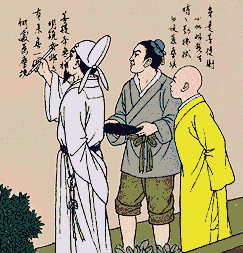
Unlike most Buddhist scriptures in China, this one was originally composed in Chinese, which in part accounts for its great popularity, since it is more accessible to literate Chinese without advanced training in Buddhism. However, several Chinese and Sinicized Sanskrit terms are used over and over even in the narrative selection offered here, requiring the translator (me) to decide whether to transliterate them (from either Chinese or Sanskrit) as technical terms of Anglophone Buddhism, or to translate them slightly inaccurately into ordinary English at the risk losing the distinctively Buddhist meanings that they carry in Chinese. Often there is an alternation between once “natively Chinese” terms (today saturated with Buddhist associations) and “equivalent” Chinese transcriptions of Sanskrit terms (now commonplace enough to seem more Chinese than Sanskrit, but also strongly Buddhist).
I have not always been consistent from one context to the next, so here is a list of the terms I have found most challenging. A review of the list is itself a brief education in Chán thinking!
- Xīn 心 = literally “heart,” often in an extended sense of sentiments or even understanding, but in Buddhist contexts often meaning mind, either instead or in addition to heart. In this text it sometimes also seems to mean something like “essential nature.” The text alternates between the importance of seeing one’s “original heart/mind” (běnxīn 本心) and one’s “own essence” (zìxìng 自性). I have retained the difference, but many contexts suggest interchangeability in this text.
- Pútí 菩提 = Sanskrit: bodhi (Japanese: satori), sometimes “enlightenment” but also often something more like insight or wisdom. The ordinary-language equivalent is usually wù 悟, to “awaken,” “realize,” or “become aware.” The term bodhi also became the name of a kind of fig tree under which the Buddha meditated (a bodhi tree), and therefore an element in many Buddhist names.
- Bōrě 般若 = Sanskrit: prajñā, wisdom or consciousness. Sanskrit distinguishes between this sort of wisdom, which is intuitive and involves our understanding of the big picture, and the wisdom of being able to make sensible judgments about the world (called vijñāna or shì 识), but prajñā is used in Chinese only in very Buddhist fixed expressions. The word is usually associated with the flashes of insight in subitist schools, and I have sometimes preferred to render it “insight.” In our text the term occurs by itself and also in the name of a scripture (sūtra) that some of the Chán masters are discussing. (See below under Scriptures.)
- Zhìhuì 智慧 = “Wisdom” but also “intelligence.” In some cases, like prajñā, of which it is a colloquial equivalent, as far as I can tell, it gives rise to “insight” as the best translation.
- Bōluómìduō 波罗蜜多 (or bōluómì 波罗蜜) = Sanskrit: pāramitā, “reach perfection,” but in the Buddhist context referring to crossing from the “shore” of the world of repetitive birth and death to the “shore” where one is no longer subject to reincarnation. The metaphor of being “ferried” from one “shore” to another as a form of salvation is very strong in Chinese, the normal, non-Sanskritic term being dù 渡. This text has charming word-play on this in chapter 9, where the Fifth Patriarch escorts his successor to a very literal ferry landing, and they discuss who should be “ferrying” whom, both literally and metaphorically. In our text the term occurs by itself and also in the names of scriptures that some of the Chán masters are discussing. (See below under Scriptures.) True to form, Sanskritic writers differentiate a numbered list of pāramitās or orientations associated with reaching perfection. These are not alluded to in our text.
- Fǎ 法 = Sanskrit: dharma, “law” or “teaching.” In Sanskrit dharma is a complex term referring to the way the universe works, or anyway is supposed to work. Not surprisingly, it is often rendered fǎ in Chinese, which means “law” but also “method,” which, I am told, goes somewhat beyond the range of the Sanskrit term. (On the other hand, the Sanskrit term also includes the notion of teaching, which goes beyond the normal range of fǎ.) In this text the term fǎ has an additional meaning, something like “mandate” or “top office” in a monastic hierarchy, but possibly also secret teachings —“method” again. (In our text, secrets are denied by Huìnéng but suspected by other players in the drama.) Thus Huìnéng receives from the Firth Patriarch the symbolic robe and begging bowl of the patriarchate, but also the fǎ. In those contexts I have retained the term dharma because I couldn’t find a translation that was both accurate and not misleading.
- Jì 偈 = Sanskrit: gatha, “song.” The term gatha seems to be used for a number of quite different literary forms. In our text it refers to a very short poem, rhymed or not, which is intended to be repetitively chanted or recited, and to be a brilliant crystallization of a doctrinal message and, potentially, to lead the user to sudden enlightenment. A gatha is longer than a mantra, but still only a couple of lines, and the difficulty that people in this story have creating gathas suggests that they are far subtler than their English translations would suggest.
- Jīng 经 = sūtra, “scripture.” Various Chinese transcriptions of the Sanskrit term (sùdálǎn 素怛缆, xiūduōluó 修多罗, xiūdùlù 修妒路, etc.) have never become colloquial. The Chinese term jīng was in use long before Buddhism came to China, and was and is used for respected texts intended to be considered authoritative. The books of the Confucian canon are, in most cases, referred to as jīng. So are countless Daoist texts. With the appearance of Buddhism it was perhaps inevitable that its sacred or semi-sacred books would be called by the familiar term jīng, although this assimilated them to Chinese ideas about scriptures in a way that some Buddhists would probably rather have avoided. In the present text I have usually preferred the familiar term “scripture” to the exotic term “sūtra,” but it carries slightly uncomfortable Christian baggage in English, just as jīng carried slightly uncomfortable Daoist and Confucian baggage.
Other Scriptures
The Chán masters in our chapter are very interested in the exposition of three important scriptures. The term pāramitā (bōluómìduō 波罗蜜多),"ferrying to perfection," occurs in the names of a two of them.
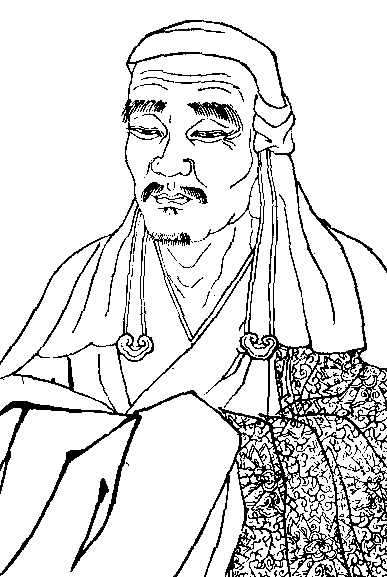
- One is the Prajñā Pāramitā Hṛdaya Sūtra (Bōrě Bōluómìduō Xīn Jīng 般若波罗蜜多心经). That is a terrible mouthful in Chinese, and it is better known as the Heart Sutra (Xīn Jīng 心经). The shortest of the Buddhist scriptures, its brevity makes it one of the most popular, despite its difficulty. A translation is available on this web site (link).
- The second scripture mentioned in our text is the Vajracchedika Prajñā Pāramitā Sūtra (Jīngāng Bōluómìduō Jīng 金刚波罗蜜多经), known simply as the Diamond Scripture (Jīngāng Jīng 金刚经). Somewhat longer, it too is one of the most popular works of the Chán school.
- Finally, towards the end of our selection we encounter the Nirvāṇa Sūtra (or Mahā Parinirvāṇa Sūtra) (Nièpán Jīng 涅槃经). This work had had many translations into Chinese by the time Huìnéng came into the world. It figures in our text because of his finesse in interpreting what was obviously considered to be one of the most difficult scriptures.
Although today these three texts, like most Buddhist scriptures, are more often chanted than understood, they all describe the insight that nothing in the world has independent reality, including ourselves, providing the comfort of knowing that our attachments to appearances are themselves illusory. Indeed, just as our very “selves” are illusory, so also are our seeming attachments to those illusory “selves.”
(Elsewhere on this website there is a brief overview of the Chinese Buddhist canon more broadly. Link)
Return to top.
Sources
My translation and interpretations of this text made use of the following sources. Where a picture has been taken from one of these sources, that fact is also noted here. The embroidered Buddhist symbols decorating the individual chapters are from a single Tibetan banner in a private collection. Passing your mouse over them should produce balloons describing them. Several chapters are illustrated by students in my 2018 class on Chinese Popular Religion at UCSD. Details are provided with each picture.
- CHAN, Wing-tsit
- 1963 The platform scripture. New York: St. John’s University Press.
- DĪNG Fúbǎo 丁福保
- 1976 六祖壇經淺註。 Tainan: 大千世界出版社。
- DĪNG Zhōnghù 丁衆祜
- 1952 六組大師法寶壇經 / The sutra of Hui Neng. (Bilingual.) Reprinted from the 1930 edition, with added annotations. Hong Kong: Buddhist Book Distributor Press & Panchiao (Taiwan): San Yang Printing Enterprise.
(The woodcut of Huìnéng was taken from this source, although it is widely printed in many other books as well.)
- EITEL, Ernest J.
- 1904 Hand-book of Chinese Buddhism, being a Sanskrit-Chinese dictionary with vocabularies of Buddhist terms. Tokyo: Sanshusha.
- HERZOG, G.
- 1971 The Heart Sutra & the Diamond Sutra. Kaohsiung: privately published.
- LÍN Shìzhǎn 林士展
- 1985 六組法寶壇經。 Taichung: 九六書局。
(The picture of the three mummified and gilded priests is from this source.)
- PRICE, A.F. & WONG Mou-lam
- 1990 The Diamond Sutra and the Sutra of Hui-neng. Boston: Shambhala Publications.
- SHÌ Xīngyún 釋星雲
- 1962 佛學頁書:經典之部 / Bilingual Buddhist series: sutras & scriptures. San Chung: Buddhist Cultural Service / 佛教文化服務處。
- SOOTHILL, Willian Edward & Lewis HODOUS
- 1934 A dictionary of Chinese Buddhist terms. Third edition. London: Kegan Paul, Trench, Trubner & Co.
- WU, John C.H. (WÚ Jīngxióng 吳經熊)
- 1967 The golden age of Zen. Taipei: National War College.
- YAMPOLSKY, Philip B.
- 1967 The platform sutra of the sixth patriarch. New York: Columbia University Press.
- YÁN Shùdōng 严曙东, CUĪ Jǐnquán 崔锦泉, & ZHĀNG Chìtáng 张炽堂
- 2000 六祖惠能大师画传。 Shanghai: 上海古籍出版社。
(The picture of Huìnéng's literate recruit writing his poem on the wall is by Gù Zōngxián 顾宗贤 from the color cover of this book.)
- YÈ Lùhuá 叶露华
- 2005 佛教小百科:历史。 Zhengzhou: 大象出版社。
(The picture of Huìnéng and two other patriarchs is by an unknown artist. It is here reproduced from p. 108 of this source.)
Return to top.
This page has received

visits since 160913.







